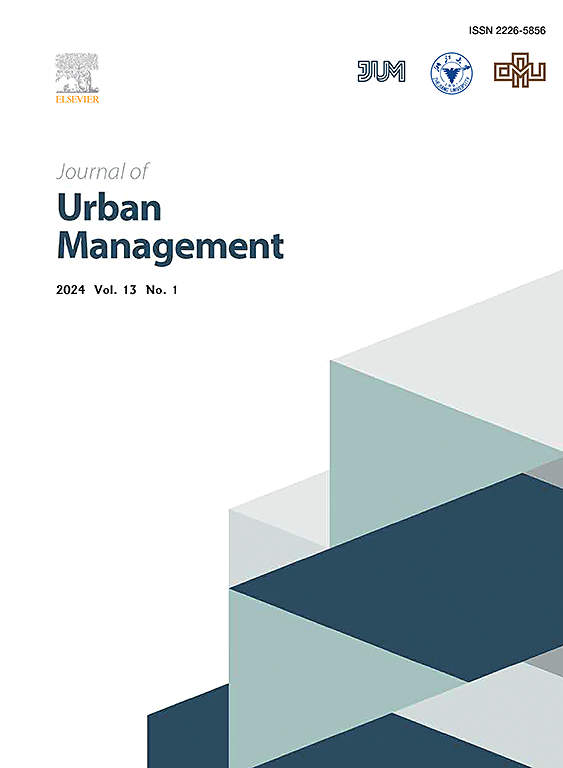Using system dynamics to inform scenario planning: Application to the Souss-Massa basin, Morocco
IF 5
2区 社会学
Q1 URBAN STUDIES
引用次数: 0
Abstract
The watershed represents a holistic system whose poor understanding of its multiple subsystems can lead to a pronounced water scarcity. This study aims to develop an innovative technique for managing water resources within the Souss-Massa watershed. It uses the System Dynamics (SD) methodology to analyze the interplay among the factors involved in water supply and demand. The results show that under the Business As Usual (BAU) scenario, water sustainability in this watershed is not assured. Groundwater drawdown (GWD) will increase significantly, with an estimated average decrease of −337 Mm3 for the period 2022 to 2050. To remedy this critical situation, several simulations were developed, each representing a distinct scenario. Scenario 1 improves irrigation efficiency by 10%, while scenario 2 achieves a 20% improvement. Scenario 3 builds on scenario 2 by doubling the volume of reused water. Scenario 4 extends scenario 3 by also doubling the volume of desalinated water. Scenario 5 combines the 10% improvement in irrigation efficiency from scenario 1 with a doubling of both reused and desalinated water volumes, along with a stabilization of irrigated areas. Scenario 6 adds a 7% increase in water supply to the measures in scenario 5. Finally, scenario 7 combines the 10% irrigation efficiency improvement from scenario 1 with a doubling of reused and desalinated water volumes, but reduces the irrigated area by 15%. This study is of crucial importance to decision-makers, as it provides them with strategies for promoting water-saving practices and, consequently, advancing the sustainable development agenda.
利用系统动力学为情景规划提供信息:在摩洛哥Souss-Massa盆地的应用
流域代表了一个整体系统,对其多个子系统的理解不足可能导致明显的水资源短缺。本研究旨在开发一种管理苏萨-马萨流域水资源的创新技术。它使用系统动力学(SD)方法来分析涉及供水和需求的因素之间的相互作用。结果表明,在“一切照旧”情景下,该流域的水资源可持续性得不到保证。地下水降水(GWD)将显著增加,预计2022年至2050年期间平均减少- 337 Mm3。为了纠正这种危急情况,开发了几个模拟,每个模拟代表一个不同的场景。情景1将灌溉效率提高10%,而情景2将提高20%。方案3建立在方案2的基础上,将回用水量增加一倍。方案4扩展方案3,也将淡化水的体积增加一倍。方案5与方案1相比,灌溉效率提高了10%,重复用水和脱盐水量增加了一倍,灌溉面积也稳定了下来。在方案5的措施基础上,方案6增加了7%的供水。最后,方案7结合了方案1中10%的灌溉效率提高,再利用和脱盐水量增加了一倍,但灌溉面积减少了15%。这项研究对决策者至关重要,因为它为他们提供了促进节水做法,从而推进可持续发展议程的战略。
本文章由计算机程序翻译,如有差异,请以英文原文为准。
求助全文
约1分钟内获得全文
求助全文
来源期刊

Journal of Urban Management
URBAN STUDIES-
CiteScore
9.50
自引率
4.90%
发文量
45
审稿时长
65 days
期刊介绍:
Journal of Urban Management (JUM) is the Official Journal of Zhejiang University and the Chinese Association of Urban Management, an international, peer-reviewed open access journal covering planning, administering, regulating, and governing urban complexity.
JUM has its two-fold aims set to integrate the studies across fields in urban planning and management, as well as to provide a more holistic perspective on problem solving.
1) Explore innovative management skills for taming thorny problems that arise with global urbanization
2) Provide a platform to deal with urban affairs whose solutions must be looked at from an interdisciplinary perspective.
 求助内容:
求助内容: 应助结果提醒方式:
应助结果提醒方式:


